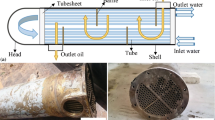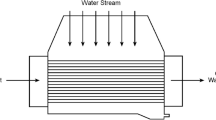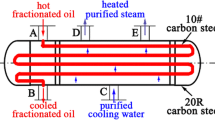Abstract
Failure assessment was carried out on admiralty brass tubes in a heat exchanger that failed after five years of service. The failed tubes had numerous circumferential grooves on the external surface due to ammonia corrosion. Inside the brass tubes, a thin layer of calcium carbonate and a minor dirt material was deposited. Under the carbonate deposits, shallow pitting corrosion was identified. Additionally, dezincification was also noticed on both external and internal tube surfaces. The failure assessment was carried out by metallographic examinations, X-ray diffraction phase analysis, scanning electron microscopy, and elemental analysis. The investigation revealed that steam passing over the tubes was contaminated with ammonia compounds, causing groove corrosion. It was also noted that cooling water running inside the tubes had improper quality, leading to deposit formation. The failure investigation suggested that the brass tubes suffered severe grooving corrosion, pitting, and dezincification. The co-occurrence of these corrosion mechanisms on both inside and outside the tube surfaces led to the tube material thinning, weakening, and failure.











Similar content being viewed by others
References
K. Rabindranath, N. Tanoli, H. Gopal, Failure investigation of brass heat exchanger tube. Eng. Fail. Anal. 26, 332–336 (2012)
K. Ranjbar, A. Taghavian, M. Amra, Failure assessment of an admiralty brass oil exchanger tubes. J. Fail. Anal. Prev. 20(1), 218–225 (2020). https://doi.org/10.1007/s11668-020-00823-y
A.V. Polunin, A.P. Pchelnikov, V.V. Losev, I.K. Marshakov, Electrochemical studies of the kinetics and mechanism of brass dezincification. Electrochim. Acta. 27(4), 467–475 (1982). https://doi.org/10.1016/0013-4686(82)85025-1
A.J. Forty, Corrosion micromorphology of noble metal alloys and depletion gilding. Nature. 282(5739), 597–598 (1979). https://doi.org/10.1038/282597a0
Z. Peng, K. Ogle, The corrosion of copper and copper alloys. Encycl. Interfacial Chem. Surf. Sci. Electrochem. (2017). https://doi.org/10.1016/B978-0-12-409547-2.13429-8
W. T. Becker and R. J. Shipley, ASM Metals Handbook Volume 11, Failure Analysis and Prevention, Ohio, America ASM Int., vol. 11. p. 448, 2002. doi: https://doi.org/10.1002/maco.200490034.
R. Davalos-monteiro, U. Kingdom, “Observations of corrosion product formation and stress corrosion cracking on brass samples exposed to ammonia environments.” Mater. Res. 22(1), 1–10 (2019)
H. Ardy, A. Setiawan, A. Wibowo, A. Sumboja, Failure analysis of admiralty brass tubes in a surface condenser: A case study at the petrochemical industry. Mater. High Temp. (2021). https://doi.org/10.1080/09603409.2021.1897944
M. Rahman, S. Al-Sulami, F. Almauili, Carbohydrazide vs hydrazine: A Comparative Study. Power Plant Chem. 20(1), 34–49 (2018)
K. Ranjbar, Effect of flow induced corrosion and erosion on failure of a tubular heat exchanger. Mater. Des. 31(1), 613–619 (2010)
Y. Wang, T. Wang, M. Sun, Failure analysis on leakage of brass condenser tube in thermal power plant. IOP Conf. Ser. Mater. Sci. Eng. 439, 52005 (2018). https://doi.org/10.1088/1757-899x/439/5/052005
J. R. Davis, “ASM Specialty Handbook Copper and Copper Alloys,” Materials Park: ASM International. p. 419–429. 2001.
J. Ulaganathan, R.C. Newman, The role of local strains from prior cold work on stress corrosion cracking of α-brass in Mattsson’s solution. Mater. Charact. 92, 127–137 (2014). https://doi.org/10.1016/j.matchar.2014.03.005
X.J. Guo, K.W. Gao, L.J. Qiao, W.Y. Chu, The correspondence between susceptibility to SCC of brass and corrosion-induced tensile stress with various pH values. Corr. Sci. 44(10), 2367–2378 (2002). https://doi.org/10.1016/S0010-938X(02)00055-0
E. Brandl, R. Malke, T. Beck, A. Wanner, T. Hack, Stress corrosion cracking and lective corrosion of copper-zinc alloys for the drinking water installation. Mater. Corr. 60(4), 251–258 (2009). https://doi.org/10.1002/maco.200805079
S. Qu, G. Yao, J.F. Tian, Z.F. Zhang, Failure analysis of the brass tubes in a lubricating oil cooler. Eng. Fail. Anal. 18(8), 2232–2239 (2011). https://doi.org/10.1016/j.engfailanal.2011.07.018
T.P. Hoar, G.P. Rothwell, The potential/pH diagram for a copper-water-ammonia system: its significance in the stress-corrosion cracking of brass in ammoniacal solutions. Electrochim. Acta. 15(6), 1037–1045 (1970). https://doi.org/10.1016/0013-4686(70)80043-3
D.J.G. Ives, A.E. Rawson, Copper Corrosion. J. Electrochem. Soc. 109(6), 458 (1962). https://doi.org/10.1149/1.2425447
S.N. Kazi, Fouling and fouling mitigation of calcium compounds on heat exchangers by novel colloids and surface modifications. Rev. Chem. Eng. 36(6), 653–685 (2020)
Z. Ahmad, “Principles of Corrosion Engineering and Corrosion Control,” 1st edition, Butterworth-Heinemann, 2006, pp. 120–270
K. Abouswa, F. Elshawesh, O. Elragei, A. Elhood, Corrosion investigation of Cu – Ni tube desalination plant. Desalination. 205, 140–146 (2007). https://doi.org/10.1016/j.desal.2006.05.013
E. Sharifi, K. Ranjbar, Dezincification assisted cracking of yellow brass tubes in a heat exchanger. Eng. Fail. Anal. 136, 106200 (2022). https://doi.org/10.1016/j.engfailanal.2022.106200
R.T. Mousavian, E. Hajjari, D. Ghasemi, M.K. Manesh, K. Ranjbar, Failure analysis of a shell and tube oil cooler. Eng. Fail. Anal. 18(1), 202–211 (2011). https://doi.org/10.1016/j.engfailanal.2010.08.022
Acknowledgments
The authors highly appreciate the financial support provided by Drilling Center of Excellence and Research Center in Shahid Chamran University of Ahvaz, and the Grant N0. SCU.EM1400.322 by Shahid Chamran University of Ahvaz.
Author information
Authors and Affiliations
Corresponding author
Additional information
Publisher's Note
Springer Nature remains neutral with regard to jurisdictional claims in published maps and institutional affiliations.
Rights and permissions
Springer Nature or its licensor (e.g. a society or other partner) holds exclusive rights to this article under a publishing agreement with the author(s) or other rightsholder(s); author self-archiving of the accepted manuscript version of this article is solely governed by the terms of such publishing agreement and applicable law.
About this article
Cite this article
Ranjbar, K., Sharifi, E. Failure Assessment of Heat Exchanger Tubes Due to Grooving Corrosion. J Fail. Anal. and Preven. 23, 739–750 (2023). https://doi.org/10.1007/s11668-023-01589-9
Received:
Revised:
Accepted:
Published:
Issue Date:
DOI: https://doi.org/10.1007/s11668-023-01589-9




